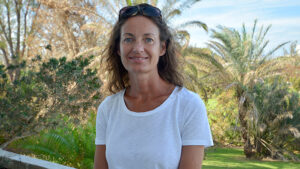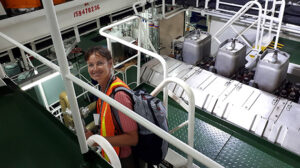In Search of Storms

For four weeks during September and October, Samantha Hallam, a doctoral student at the University of Southampton, interned at BIOS with funding from the SPITFIRE program at her institution. During her time in Bermuda, her research focused on investigating whether ocean heat content data collected from Hydrostation ‘S,’ a long-term research mooring off Bermuda, can be used in place of sea surface temperature data to provide better estimates of hurricane intensity for forecasting purposes.
Samantha Hallam, a doctoral student at the University of Southampton National Oceanography Centre in the United Kingdom, has been fascinated by storms since she spent time sailing dinghies as a little girl in her hometown of Hampshire, England. This interest in “storminess,” as she puts it, drove her education, beginning with an undergraduate degree in environmental science from the University of East Anglia in 1990. This was followed by a master’s degree in ocean science from the University of Southampton in 2014, where her thesis research was on ocean influences on the North Atlantic jet stream – a narrow band of fast-moving wind that plays a large role in weather across western Europe.
During her doctoral research, Hallam applied to the Southampton Partnership for Innovative Training of Future Investigators Researching the Environment (SPITFIRE) program at the University of Southampton to undertake an internship placement. She was accepted, and chose to do a month-long placement with Mark Guishard, program manager of the BIOS Risk Prediction Initiative (RPI), whom she met in June 2018 at the Atmospheric Science Conference in York, United Kingdom. Her love of storms still very much intact, she scheduled her internship during the months of September and October to maximize her chances of experiencing a hurricane and, much to her surprise, was greeted by Hurricane Humberto mere days after her arrival.

During her internship at BIOS, Hallam had the opportunity to tour the shipping vessel Oleander, which transports goods to Bermuda while also serving as a “volunteer observing ship” that collects oceanographic data while in transit. The Oleander’s weekly travel between Bermuda and New Jersey provides an invaluable source of data for scientific research on ecologically and climatically important regions of the western North Atlantic Ocean.
Under Guishard’s guidance, her work at BIOS has a Bermuda-specific approach, using data collected on and around the island to look at hurricane trends. Specifically, she is looking at whether the heat content of water in the ocean can provide better estimates of storm intensity than sea surface temperature (SST). She began by looking at the tracks of hurricanes that have come within 62 miles (100 kilometers) of Bermuda since 1880 to describe broad historical trends. Combining this information with SST and heat content data from Hydrostation ‘S,’ a long-term research mooring off the coast of Bermuda, she then calculated the theoretical maximum intensity of storms and compared them with the actual intensities.
Hallam’s initial findings show that, based on these data, storms have not been as intense in this region as would be expected from theory. She’s also discovered that ocean heat content data collected at a depth of 164 feet (50 meters) seems to improve the predictability of potential hurricane intensity in Bermuda.
“The classical theory of hurricane development in the tropics assumes you have a deep ocean that’s all the same temperature but, here in Bermuda, the temperature at the surface can be warmer than down at 50 meters, so the deeper measurement may be a better predictor of storm development,” she said. “This may mean that we can use data from Hydrostation ‘S’ to help inform the prediction of hurricane intensities around Bermuda on daily and seasonal scales.”
This work ties in nicely with her doctoral research looking at how a system of currents in the Atlantic Ocean, known as the Atlantic meridional overturning circulation (or AMOC), influences tropical cyclones, or hurricanes, in the region. The AMOC brings warm waters from the Southern Hemisphere into the North Atlantic by way of the Gulf Stream, which runs along the eastern coast of the United States before making a sharp turn to the east. Once the waters of the AMOC reach the higher latitudes of the Nordic and Labrador Seas, they cool and sink before beginning their journey back south.
This circulation pattern, in which ocean currents are driven by differences in temperature and density (or salinity) is called “thermohaline circulation” (thermo- referring to heat and haline referring to salt content). Many oceanographers refer to thermohaline circulation as the ocean’s “conveyor belt” to describe how it efficiently transports water throughout ocean basins, helping to regulate climate in the North Atlantic and the rest of the world.
Hallam is interested in how variations in the AMOC over seasons, between years, and over decades impact the formation of tropical cyclones. “When the AMOC slows down, it leads to a buildup of heat in the tropical Atlantic,” she said. “Tropical cyclones typically need a water temperature of at least 26 degrees Celsius (79 degrees Fahrenheit) to form, so this build-up could lead to the development of more storms.”
The AMOC displays a significant amount of variability in its speed from year to year. In 2005 and 2010, two of the most active hurricane seasons in the Atlantic, the AMOC slowed in the preceding winter months which, in turn, led to a buildup of heat in the ocean during the summer of the following year and a more active storm season. Hallam believes that studying the AMOC can help scientists more accurately predict hurricanes, which may enable coastal communities to better anticipate and prepare for storm-related impacts. Hallam published this work with her co-authors in Nature Communications earlier this year and recently presented it at a BIOS Seminar as part of her internship.
During her time in Bermuda she attended the two-day Insurance-linked Securities (ILS) Bermuda Convergence 2019 event, which brings together insurance and reinsurance companies, as well as regulators, scientists, and professional service partners. In addition, she will be presenting her research on the 2017 Atlantic Hurricane season, an early part of her doctoral research, to AXA XL, Axis Capital, RenaissanceRe, and other companies who are supporters of RPI. Hallam is due to finish her doctoral degree in the summer of 2020, at which point she will begin looking for postdoctoral research opportunities.
